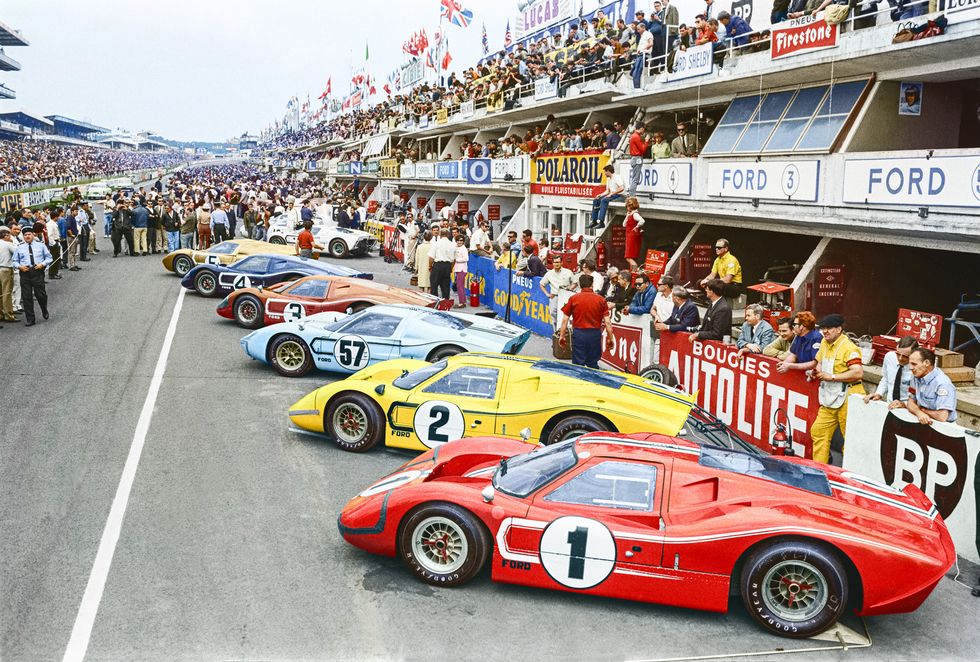This is the car that revenge built. Quick history: In the '60s, Ford was in talks to purchase Ferrari, but the Italian carmaker rebuffed the deal. Supremely miffed, Henry Ford II sought to kick the prancing horse where it would hurt most by winning the 24 Hours of Le Mans, an endurance race Ferrari had dominated that decade. And so the original Ford GT was created solely for that purpose, bringing home the checkered flag in 1966, 1967, 1968, and, for good measure, 1969. The company pulled out after that, satisfied that it had delivered one of the most memorable up-yours in corporate history.
While the 2005 Ford GT was unabashedly a scanned-and-printed version of the '60s racer, the current model is almost alienlike. It was secretly created by a passionate few, in basements at off-hours, to beat Ferrari again on the 50th anniversary of that first Le Mans victory. (It won.) The cockpit is shaped like a water droplet. The rear "pods," or hips, if you will, connect to the car by flying buttresses that would make Notre-Dame de Paris jealous. Air even flows through the rear taillights.
It does not look like a nerdy graduate dissertation in aerodynamics, however. You could bottle up its sex appeal and sell it as a cologne. It has show-off switchblade "doors of a billionaire," to borrow a phrase from Silicon Valley's endearingly dickish rich guy Russ Hanneman, who thinks standard doors, even on a Maserati, are for losers. But would a guy like him buy a car like this? The question is: Could he? To purchase one of 1,000 GTs, you must apply; a small group of Ford employees is in charge of going through the thousands of applications. If you're likely to drive the thing regularly and not keep it vacuum-sealed in a garage, your chances increase. Russ has a shot there. They also take into account whether you'll use the car for charity purposes. Sorry, Russ.
Inside, I was surprised to find cup holders. They're an odd vestige on this highly evolved supercar, which has been conjured with a brutal, engineerlike rawness. In other words, you'll discover copious amounts of carbon fiber, but you won't find a glove compartment. The seat is bonded, immovably, to the chassis as a weight-saving measure. For an adequate driving position, the pedals move to you with the tug of a nylon strap. A sliver of a rear windshield is seemingly all that separates you from a 647-hp engine planted midship, inches from your head. It can get warm inside, I was told, so wear light clothes. What a way to commune with the car. Cockpit as sweat lodge. Would I enter a new dimension?
I was hoping so. The numbers are of the face-melting variety: 0 to 60 mph in approximately 2.8 seconds. Top speed of 216 mph. The average mpg is a nihilistic 14. No matter: Those who pay $450,000 for a vehicle do not cruise the interstate for deals on Regular. That these out-there figures come from a V-6 EcoBoost engine, similar to the ones powering Ford's more proletarian products (like the F-150), is both impressive and sacrilegious. Don't you need at least two more cylinders to get into Club Supercar? Four to eight more to dance in the VIP section? Has Ford even heard of bottle service?
With one drive, there is no doubt that the six-banger, with the aid of innovative turbos sucking in air with the purposeful snarl of a T. rex, is capable. Did I reach a higher plane during my track laps? Whereas the trend in supercars is to make them easier to drive through computerized assistance so that their owners instantly feel like Senna, the Ford GT is more old-school, more honest. It is a race car that is begrudgingly street-friendly. Switch the dial on the squared-off steering wheel from Sport to Track mode and the GT drops the car a mere two inches from the ground in a split second—thunk—like an F1 missile ready to sprint out of the pit lane. Exceptionally one with the road—any loose piece of gravel you cross is heard chattering against the carbon-fiber wheel wells—it rewards moments of skill. For those other times, silicon chips nudge you in the right direction, but the GT will let you know you've hit the gas too early coming out of that apex. Over time, it put as much fear in me as it did confidence. Addictive. Dangerous. Euphoria that felt earned. I emerged from the billionaire doors sweaty, a smarter, more experienced driver, wanting to do it all over again.
Where do I apply?
This article originally appeared in the August '17 issue.















